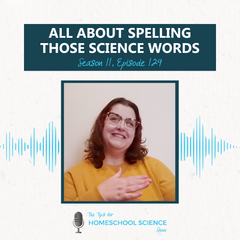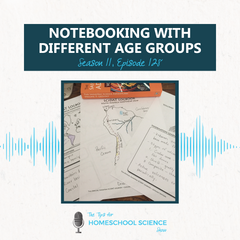FREE Shipping on all our products! (Please Note: Orders may experience a delay of a week or more in shipping due to the high volume of orders at this time of year.)
FREE Shipping on all our products! (Please Note: Orders may experience a delay of a week or more in shipping due to the high volume of orders at this time of year.)
The hurdle of experiments - I want to teach science session, part 1 {Episode 41}
March 12, 2018 2 min read

The hurdle of experiments - I want to teach science session, part 1 {Episode 41}
Are experiments keeping you from teaching science at home? My friends, it should not be so - you can add in hands-on science to your homeschool! In today's episode, we are going to chat about the first hurdle that can stand in the way of you wanting to teach science - experiments.
Hi, I’m Paige Hudson and you are listening to the Tips for Homeschool Science Show where we are breaking down the lofty concepts of science into building blocks you can use in your homeschool!
Listen to this episode
Share the Tips
If you found these homeschool science tips to be helpful, would you please take a moment to rate it on iTunes or Stitcher? This would help me tremendously in getting the word out so that more earbuds are filled with science-teaching encouragement.
Highlights

Do we even need to teach science in the first place? Yes! As homeschoolers, we have the privilege of sharing this amazing subject with our students.
But, the number one struggle I hear with teaching science is having to do experiments.
Why you need experiments in your homeschool?
- Experiments are the hands-on aspect of science.
- Experiments provide practical reinforcement of what the students are studying.
- Experiments allow students to interact with science face-to-face, showing them that science is more than just facts and figures.
Getting over the "experiments at home" hurdle - remember that ALL experiments are learning opportunities.
Tips for experiment success
- Have the materials on hand.
- Read ahead
- Follow the directions
- Try, try again.
What to do when an experiment fails
- Re-read the directions.
- Read the expected results and explanation.
- Ask several questions.
- Correct and try again.
Takeaway Tidbits
As homeschoolers, we have the chance to make science enjoyable and not intimidating. Experiments can help us do this. (Pin this Tidbit)
Experiments provide the practical reinforcement that our students need when learning about science. (Pin this Tidbit)
All experiments are learning experiences, even when they don't go as planned. (Pin this Tidbit)
Additional Resources
See the full conference session - I want to teach science, but these three hurdles stand in my way.
Check out the following articles for more tips to leap over the hurdle of experiments:
Also in {Podcast} The Tips for Homeschool Science Show
All About Spelling Those Science Words {Season 11, Episode 129}
March 25, 2024 7 min read

In this episode, we'll be interviewing Robin Williams from All About Spelling. Click "Read More" to listen is as we discuss tips and tricks for spelling all those science words!
How should you handle notebooking through the different ages? {Season 11, Episode 128}
March 18, 2024 3 min read

Writing in Science with a Well-Trained Mind (Interview) {Season 11, Episode 127}
March 11, 2024 16 min read

Click "Read More" to listen in as Susan Wise Bauer and Susanna Jarret join Paige to share tips and tools about the third key to teaching science!
Subscribe
Sign up to get the latest on sales, new releases and more …

